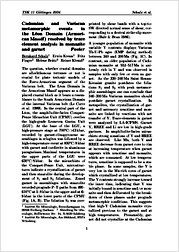Cadomian and Variscan metamorphic events in the Léon Domain (Armorican Massif) resolved by trace element analysis in monazite and garnet
2006Universitätsverlag Göttingen
Sammelband- / Konferenzbeitrag
Verlagsversion
Deutsch
Schulz, Bernhard; Krenn, Erwin; Finger, Fritz; Brätz, Helene; Klemd, Reiner, 2006: Cadomian and Variscan metamorphic events in the Léon Domain (Armorican Massif) resolved by trace element analysis in monazite and garnet. In: Philipp, S.; Leiss, B; Vollbrecht, A.; Tanner, D.; Gudmundsson, A. (eds.): 11. Symposium "Tektonik, Struktur- und Kristallingeologie"; 2006, Univ.-Verl. Göttingen, p. 203 - 205., , DOI: 10.23689/fidgeo-1896.
 |
Dokument öffnen: |
The question, whether crustal domains
are allochthonous terranes or not is
crucial for plate tectonic models of
the Ibero-Armorican segment of the
Variscan belt. The Léon Domain in
the Armorican Massif appears as a displaced
crustal block as it bears a resemblance
to the South Armorican Domain
of the internal Variscan belt (Le Corre
et al. 1989). In the central part of the
Léon, the amphibolite-facies Conquet-
Penze Micaschist Unit (CPMU) overlies
the high-grade Lesneven Gneiss Unit
(LGU). At the base of the LGU, a
high-pressure stage at 700°C/>13 kbar,
recorded by garnet-clinopyroxene assemblages
in eclogites was followed by a
high-temperature event at 800°C/8 kbar
with garnet and cordierite in aluminous
paragneisses. Maximal temperatures in
the upper parts of the LGU were
630°C/6 kbar. In the micaschists of
the Conquet-Penze Unit, microstructures
indicate a crystallization of garnet
and then staurolite during the development
of S1 and S2 foliations. Zoned
garnet in assemblages with staurolite
recorded prograde P–T paths from 490–
610°C at 5–8 kbar in the upper and at 6–
9 kbar in the lower parts of the CPMU. The foliation S2 was overprinted by shear bands with a top-to-
SW directed normal sense of shear, corresponding
to a dextral strike-slip movement
(Balé & Brun 1986).
A younger population of monazite with
variable Y contents displays Variscan
Th-U-Pb ages (EMP dating method)
between 340 and 300Ma. In
contrast, an older population of Cadomian
monazite at 552–517Ma is uniformly
rich in Y and was observed in
samples with only few or even no garnet.
As the 330–340Ma Saint Renan-
Kersaint granite postdates the foliations
S1 and S2 with peak metamorphic
assemblages one can conclude that
340–300Ma Variscan monazites should
postdate garnet crystallization.
Statistik:
ZugriffsstatistikSchlagworte:
Armorikanisches GebirgeVariskische Gebirgsbildung
Assyntische Faltungsphase
Metamorphose <Geologie>
Monazit
Geochronologie
Amorikanisches Massiv und Randzonen {Geologie}
Metamorphe Komplexe, übriges Europa {Petrologie}
Schwerminerale
Geochronologie einzelner Regionen im allgemeinen
Lanthanoiden Lanthaniden, Seltene Erden {Geochemie}
Analysedaten von Mineralen und Mineralparagenesen

